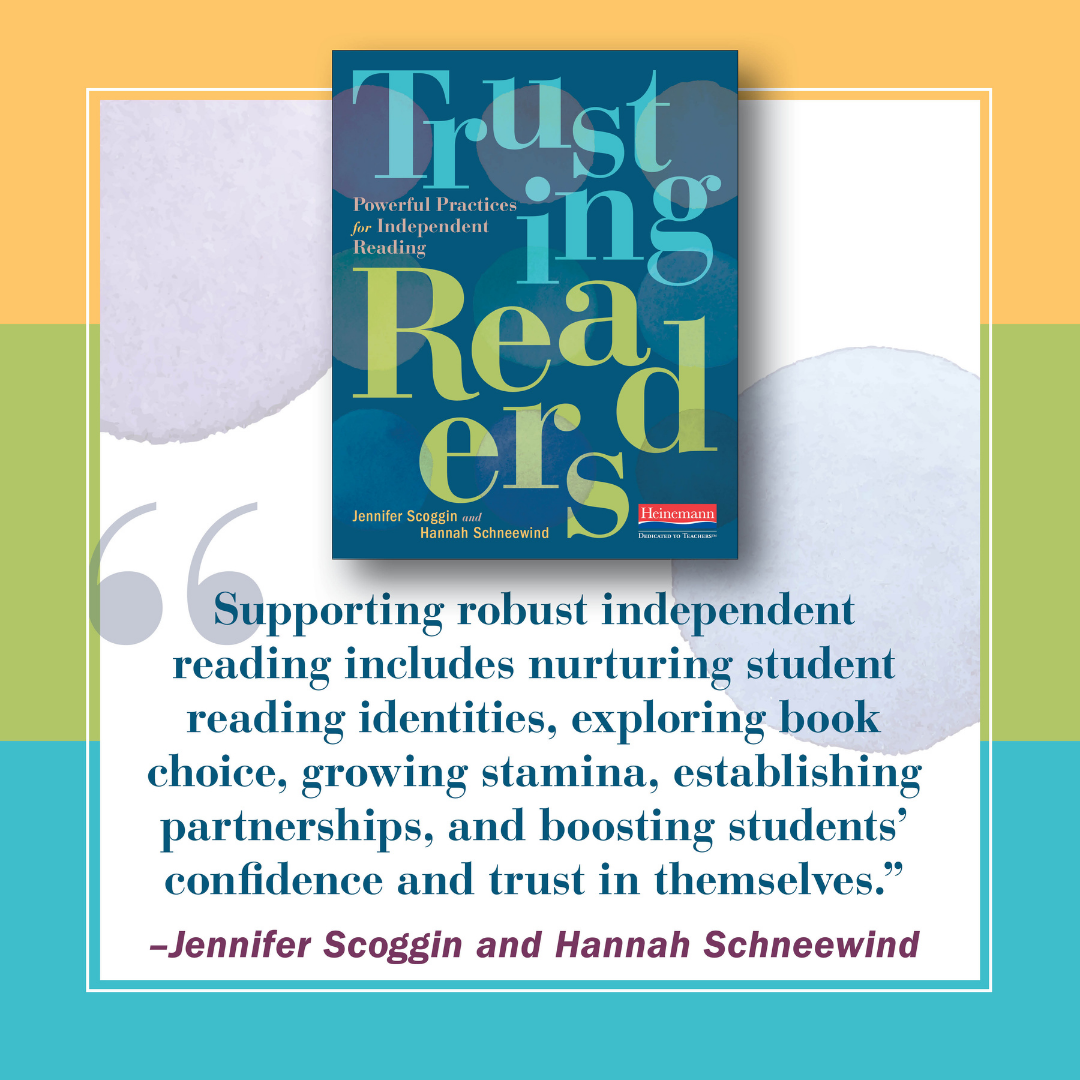

Teachers have the unique opportunity to start fresh each year. This fresh start often begins with designing the classroom space for a new group of students. Think of the classroom as a blank canvas for your students; what messages does it send about the type of learning that is promoted and valued in that space? As we linger in classrooms, we uncover the stories of individual and collective learning.
In these summer months, our inboxes are flooded with advertisements for sales on bulletin board paper, cute theme cut outs and classroom decor. As much as we love a good color palette, classroom spaces that are overly decorated and “finished” on the first day of school leave little room for students to share their stories or find a space for their identities as readers. Instead of starting by thinking about classroom decor, what’s the best that could happen if you start by thinking about your values? Then ask yourself, “How can I design a classroom space that reflects these values?”
There is a difference between decorating your classroom and intentionally designing your classroom. As educators who value independent reading as a central piece of literacy instruction, going back to better this school year includes crafting well-imagined classroom spaces that foster agentive and joyful independent reading from day one.
Using the Principles of Independent Reading to Design Classroom Spaces
Our definition of impactful independent reading is based on four principles: time, choice, talk and teacher support. The chart below expands upon how each of these principles work in concert to nurture and sustain joyful independent reading that leads to significant academic growth.
| Principle | What it allows students to do... | What it allows teachers to do... |
| Time | ...have long stretches of the day to lose and find themselves in text. There is a direct correlation between reading volume and increased reading skill. | ...observe and learn about their students as readers. This kidwatching is vital in order for teachers to craft more specific and powerful feedback. |
| Choice | ...read texts they selected themselves, which means they will be more motivated to keep reading. Choice also gives students the chance to enact, explore and stretch their identities as readers. | ... come to better understand the identities of their students as readers by paying attention to their choices. Give book recommendations. Teach into the ways in which readers can make purposeful choices. |
| Talk | ...comprehend texts in new ways, build on one another’s ideas, and read for longer stretches of time. | ...listen to how students negotiate meaning. Coach into conversations. Act as a reading partner. |
| Teacher Support | ...receive feedback related to their personalized reading goals, which allows them to grow as readers. | ...provide targeted feedback through one-on-one conferring. Feedback is one of the most impactful methods of instruction at our disposal. |
When we value time, choice, talk and teacher support in independent reading, we can design a classroom that promotes these principles.
The Classroom Library
The location and design of the classroom library should send the clear message that all readers are valued in that space. The ideal classroom library is organized to inspire readers, is accessible, and encourages students to use it independently. Below are some ideas for launching and maintaining your classroom library:
Make the classroom library a central feature. Create cozy spaces to meet and learn together surrounded by books.
Dedicate time to organizing the library collaboratively. Organize and display some, not all of your collection. Model for students how you might organize reading choices by putting out a few labeled baskets of tried and true favorites. Leaving space for students to imagine and develop their own plans for this shared space creates a sense of ownership and connection to the classroom library.
Encourage choice by auditing your library regularly. The classroom library should provide, encourage and celebrate student choice. Stay current with popular new titles, intentionally purchase texts to maintain an inclusive collection and remove those titles that no longer resonate with students or are culturally insensitive. Involve students in the process.
Facilitate talk about how to organize and use the library. Introduce assortments of books to open up conversations about how the library could be organized. There are limitless possibilities here! Classroom libraries can be organized to reflect the identities, preferences and interests of the collective group, telling the story of the readers who learn together in that space.
Support students’ evolving reading identities. Listen to your students while they are in the library; use this information to expand or refine your collection. Support students in how they can use the library to make strategic text selections as they explore and grow their identity as readers. Encourage students to suggest ways to reorganize the library, new titles to include or collections to put away for now.
When students play an active role in organizing and picking books for the classroom library, they know that their reading identities are valued and that the library belongs to everyone.
The Classroom Walls
What goes on the classroom walls has the potential to be impactful and empowering; the anchor charts and student work on display can both reflect and support independent reading. Intentionality and restraint are key here. This might mean that walls feel welcoming but sparse on day one so that there is space for students to construct a collective and inclusive learning space. Below are ideas to inspire walls that reflect the principles of time, choice, talk and teacher support.
Dedicate time for students to make the classroom their own. Consider which spaces might be used freely for students to express and share their thoughts and identities freely and creatively.
Offer choices for students to co-construct anchor charts. Make your anchor charts dynamic and alongside students. Include anchor charts created by individual students, in partnerships or as a small group. Make some charts through interactive writing. Include multilingual charts that honor the multiple languages spoken within the classroom. You can also collaborate with students to create visually compelling charts that include digital or hand drawn images.
Talk with students about how anchor charts and student work can support their independent reading. Model referring to classroom walls. For example, you might explicitly discuss with students how to use a co-constructed anchor chart that captures what students can think about while selecting texts from the classroom library. Or you might demonstrate how students can refer to posted work that models a variety of ways to respond to a text.
Keep walls current to support student independence. Anchor charts and student work can quickly become wallpaper that everyone simply ignores. Take time to reflect on your walls with students and kidwatch to notice which artifacts are relied upon regularly. What artifacts are still useful? Which artifacts can be retired to a less prominent (but still accessible) space?

We send students messages about what we value the moment they walk into a classroom space. What stories are valued here? Whose classroom is this? Classroom spaces that are created with and by students have the power to become joyful and dynamic spaces that foster agentive and engaged independent reading.
Kidwatching during Independent Reading
In the first days of the school year, kidwatching is an essential piece of small data collection. Small data refers to the type of authentic, targeted formative assessment that supports teachers in making effective instructional decisions. Historically, schools and teachers measure what they value. Part of going back to better independent reading is kidwatching with time, choice, talk, and teacher support in mind.
Remember that engagement is the ultimate goal for our readers. Engagement in independent reading is fueled by the principles of time, choice, talk and teacher support. In turn, kidwatching with these values in mind also uncovers key information about levels of student engagement with reading.
Use the chart below as you kidwatch and take notes.
Going Back to Better in Independent Reading
As teachers, some of our most essential work is to intentionally design classrooms that support and reflect our values. We can go back to better by co-creating classroom spaces alongside students that support and extend independent reading by reflecting on the key principles of independent reading: time, choice, talk and teacher support. We trust teachers to design inviting spaces and teach readers. How can you trust yourself to go back to better independent reading in the coming school year?
To learn more about Trusting Readers visit Heinemann.com.
Click below to read the previous posts.

Dr. Jennifer Scoggin has been a teacher, author, speaker, curriculum writer, and literacy consultant. Jennifer’s interest in the evolving identities of both students and teachers and her growing obsession with children’s literature led her to and informs her work. Jen began her career teaching first and second grades in Harlem, New York. In her current role as a literacy consultant, Jennifer collaborates with teachers to create engaging literacy opportunities for children. She holds a doctorate in curriculum and instruction from Teachers College, Columbia University and has previously published two books about literacy instruction and life in the classroom.

Hannah Schneewind has been a teacher, staff developer, curriculum writer, keynote speaker and national literacy consultant. She brings with her over 25 years of experience to the education world. Hannah’s interest in student and teacher agency and her belief in the power of books informs her work with schools. Hannah began her career as a first grade teacher at P.S. 321 in Brooklyn, New York, and her classroom was used as a model classroom for teachers around the city and country. The trust the administrators placed in her along with the culture of collaboration in the school formed her beliefs in the power and possibilities of schools. Together, Jen and Hannah created Trusting Readers, a group dedicated to collaborating with teachers to design literacy opportunities that invite all students to be engaged and to thrive as readers and writers. 






